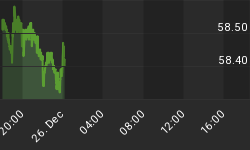A few weeks ago I suggested that the U.S. stock market was disguised in bull's clothing. The crux of my suggestion focused on the identification of secular bull and bear markets. I concluded that although the market is, from a trend perspective, bullish, the underlying secular trend is bearish. The importance of understanding secular cycles cannot be understated. There can be very strong bullish moves within a secular bear market - what we have now. The converse is also true. There could be very strong bearish moves within a secular bull market.
I got my feet wet in the commodity markets through the study of legendary trader W.D. Gann. In futures trading, the trend is your friend. A trader is a very different animal than an investor but there are times that investors need to behave like traders.
If you accept the premise that the market is in a secular bear cycle (albeit currently in a bullish run) and that a flurry of contrary sentiment indicators reveal a market much closer to a top than a bottom, then the next step is identifying a trend change. During the time I was more active in the futures market, I co-developed trading software that helped in trend identification. Some of the same indicators are useful in the U.S. stock market.
The indicators are derived from trend-following algorithms for three time horizons (short, medium, and long-term). The Short-Term (ST) indicator encompasses daily price movement, the Medium-Term (MT) indicator looks at weekly patterns, while the Long-Term (LT) indicator focuses on monthly price action. Other horizons could certainly be employed. For example, I have seen many charts that track price movement in 5 minute increments, certainly appealing for day traders. I simply chose those three for the sake of simplicity and convenience.
Understandably, the ST indicator oscillates the most of the three. Throughout the course of a given year, the ST indicator can change from bullish to bearish and vice versa many times. Prior to the last week of July 2014, the ST indicator turned bearish in the Dow only once in 2014 and that was at the beginning of the year. The MT indicator also did not turn bearish in 2014. More on this ahead. Since the market bottom of 2009, the MT indicator has turned bearish only twice (June 2011 and May 2012). The LT indicator has never turned bearish since the 2009 bottom. The trend in all three time horizons has been overwhelmingly bullish since 2009.
Each indicator suggests trend on a daily (ST), weekly (MT), or monthly (LT) basis. From an investor's perspective, if the ST indicator changes, I don't get too excited. For that same perspective, a trend change in the MT indicator is significant. This suggests a change in trend measured in weeks as opposed to days.
The week ending 8/7/15 was important in the Dow Jones Industrial Average. For reference, see the weekly chart below courtesy of CSI with my annotations.

This week acquired more significance since there were a couple of instances in 2014, where the Dow was close to an MT trend change. The first instance was in February of 2014 ("Close but not quite") and the second instance in October of 2014 was what I termed The October Surprise. In both February of 2014 and October of 2014, the market made a great recovery in the week highlighted. It did not have such a recovery last week. As a result, a Medium-Term indicator changed to bearish.
Another example of the MT indicator changing to bearish occurred several months ago in the Dow Jones Utilities (DJU). Once again, I refer you to the chart below, which is a weekly chart of the DJU.

The Dow Utilities have been in a bear market, for many weeks and now approaching six (6) months. Now let's look at a market where no indication has manifested. The weekly chart below is of the S&P 500. In this market's case, no MT trend change is evident.

What can we conclude? By many contrary sentiment and historical measures, the market is considerably closer to a top than a bottom. Those believing that we are in the middle of a bull market or even the start of one, have the weight of historical evidence against them. Important bearish trend signals at the weekly chart level (medium-term trend) are in effect for the DJIA and the DJU. Broader indices such as the Value Line and the Russell 2000 are also exhibiting weakness.
There is insufficient evidence to declare the end of the bull market since 2009 (see the S&P 500 chart). We are, however, under bearish influences in several markets. The price action last week in the DJIA is another important nail in the bull's coffin. Now is an excellent opportunity for investors to start thinking like traders.















